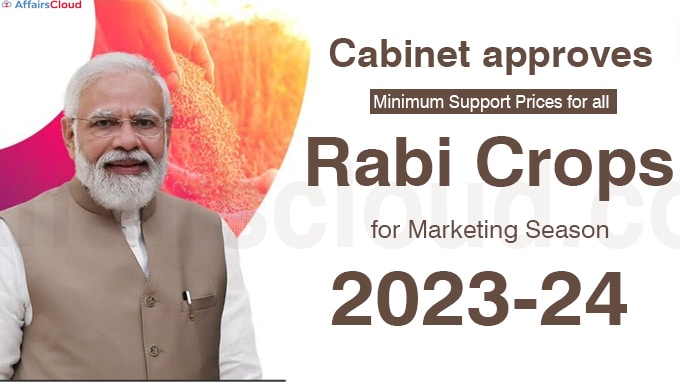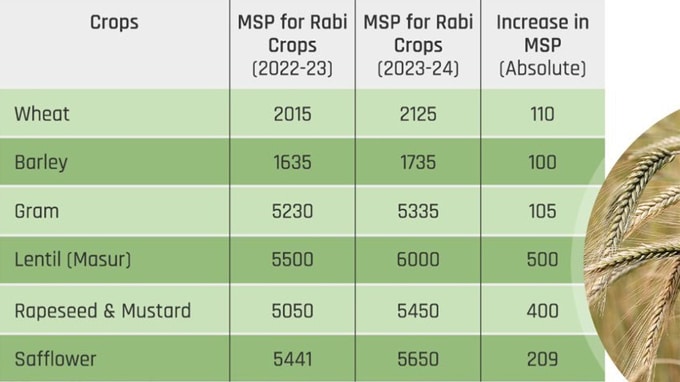 On October 18, 2022, the Cabinet Committee on Economic Affairs (CCEA) chaired by the Prime Minister (PM) of India Narendra Modi, has approved the increase in the Minimum Support Prices (MSP) for all mandated (6) Rabi for the 2022-23 crop year (July-June) and the 2023-24 marketing season.
On October 18, 2022, the Cabinet Committee on Economic Affairs (CCEA) chaired by the Prime Minister (PM) of India Narendra Modi, has approved the increase in the Minimum Support Prices (MSP) for all mandated (6) Rabi for the 2022-23 crop year (July-June) and the 2023-24 marketing season.
- This decision has been taken to ensure remunerative prices to the growers for their produce.
Increase in MSP (Absolute):
MSP is the rate at which the government buys grain from farmers. Currently, the government fixes MSPs for 23 crops grown in both Kharif and rabi seasons.Sowing of rabi (winter) crops begins in October, immediately after the harvest of kharif (summer) crops. Wheat and mustard are major rabi crops.
i.The absolute highest increase in MSP for lentil (Masur) is at Rs 500/- per quintal followed by rapeseed and mustard at Rs 400/- per quintal.
ii.For safflower, there is an increase of Rs 209/- per quintal.
iii.For wheat, gram and barley, there is an increase of Rs 110/- per quintal, Rs 105/- per quintal and Rs 100 per quintal respectively.
MSP for all Rabi Crops for Marketing Season 2023-24
| Crop | MSP 2022-23 (Rs Per quintal) | MSP 2023-24 (Rs Per quintal) |
|---|---|---|
| Wheat | 2015 | 2125 |
| Barley | 1635 | 1735 |
| Gram | 5230 | 5335 |
| Lentil (Masur) | 5500 | 6000 |
| Rapeseed & Mustard | 5050 | 5450 |
| Safflower | 5441 | 5650 |
Key Points:
i.This increase is on the lines of FY19 Union Budget announcement of fixing the MSP at a level of at least 1.5 times of the All-India weighted average Cost of Production.
- It was decided to provide a maximum rate of return of 104% for rapeseed & mustard, followed by 100% for wheat, 85% for lentil; 66% for gram; 60% for barley; and 50% for safflower.
ii.The Central Government prioritizing on increasing the production of oilseeds and pulses through area expansion, productivity through High Yielding Varieties (HYVs), MSP support and procurement. This will aid in fulfilling the objective of Atmanirbhar Bharat.
Smart farming methods promoting by the Government:
Digital Agriculture Mission (DAM), which includes India Digital Ecosystem of Agriculture (IDEA), Farmers Database, Unified Farmers Service Interface (UFSI), National e-Governance Plan in Agriculture (NeGPA), Revamping Mahalnobis National Crop Forecast Centre (MNCFC), Soil health, Fertility and profile mapping.
- Under the NeGPA programme, funding is given to State Governments for Digital Agriculture projects using technologies like Artificial Intelligence and Machine Learning (AI/ML), Internet of Things (IOT), Block chain etc.
- To promote smart farming, the Government also promotes Startups in the Agriculture sector and nurtures agri-entrepreneurs.
Recent Related News:
i.The Uttar Pradesh (UP) Government is set to launch the Panchamrut Yojana, with the goal of doubling farmers’ income through the implementation of cost-effective technical measures and the promotion of co- cropping methods.
ii.Godrej Agrovet signed three Memorandum of Understanding (MoU) with Assam, Manipur and Tripura state governments for the development and promotion of oil palm cultivation in the region under the National Mission on Edible Oils-Oil Palm (NMEO-OP) scheme.
Static Information:
i.Minimum Support Prices (MSP) is the rate at which the government buys grain from farmers.
ii.Currently, the government fixes MSPs for 23 crops grown in both Kharif and rabi seasons.
iii.Sowing of rabi (winter) crops begins in October, immediately after the harvest of kharif (summer) crops.
iv.Wheat and mustard are major rabi crops.




